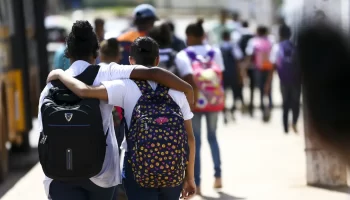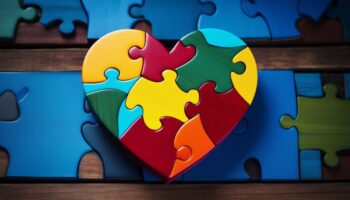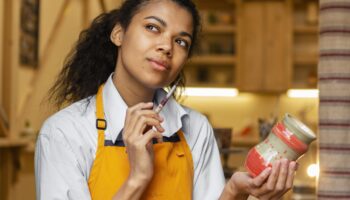Having access to quality education is a right of all Brazilians, according to the articles of the Constitution. But, in reality, many students do not receive the necessary structure to develop their studies.
According to educational indicators, students from public schools perform worse than those from private institutions. Likewise, education in rural areas lags behind that in urban areas. Even in the same city, there are differences between schools: those located in prime areas do better than those located on the outskirts.
Check out some data on Brazilian education by stage of education and the challenges to democratize quality education.
Child education
This stage ranges from 0 to 5 years of age and includes going through day care centers and preschool. As it is an extremely important phase of life for socialization and cognitive and motor development, the State Education Plan (PNE) established a goal that, by 2024, half of children aged up to 3 years old will attend daycare centers and all those aged between 4 and 5 years old are enrolled in the school.
According to data from the Yearbook of Basic Education released in 2021, access to day care reached 58.4% of children between 0 and 3 years old. But inequalities already begin at this stage of education: while 54.3% of children living in the richest households were enrolled, only 27.8% of those who came from poorer households attended daycare centers. Among rural area residents, only 20.4% were enrolled.
In preschool, the percentage of enrollment reached 94.1%. Unlike what happens in day care centers, the differences according to race/color, income and location are smaller. That is, it is closer to achieving democratization.
Elementary School
We can divide elementary education into two stages: the initial and final years. In the early years, children learn to read and write, interpret texts and perform simple mathematical calculations, for example.
In the final years, they should already be able to interpret and write long texts, develop more complex mathematical calculations, for example. At this stage, the rate of enrollment between 6 and 16 years old reaches 98%, a level close to the 100% established as a target by the PNE. In absolute numbers, 158,888 Brazilians between the ages of 6 and 16 are out of school.
Likewise, the text also dictates that 95% of students complete this stage at the correct age. However, the fulfillment of this goal is still not close to reality.
According to the Yearbook, the rate of completion of elementary school up to the age of 16 is 82.4%. This phenomenon, called age-grade distortion, is mainly caused by the inequalities found both in income and in race/color. The perspective is that, in the coming years, there will be a worsening in this situation, due to the difficulties imposed by the pandemic.
Far from quality education
Another problem is the low learning performance of students. The Basic Education Assessment System (SAEB) analyzes the proficiency of students in the initial and final years of elementary school. For this, it uses a scale from 0 to 8, where 0 is the most basic level and 8 is the most complex, and a score that varies between 0 and 1000.
Just by way of comparison, see the difference in Portuguese language proficiency in the 2nd and 9th year of elementary school:

In the last edition with published results, referring to 2019, 4.62% of 2nd year students were at level 0. In 1, there are 4.22% of students, while in 2 are 6.72%. 11.9% are at level 3 and 17.8% at 4. Most students reached levels 5 and 6 of the scale, totaling 39.94%. Level 7 was achieved by 9.74% of students and level 8 by only 5.04%. The country’s average score was 750.
In the 9th grade, the numbers are much lower: 14.02% are at level 0; 11.62% at level 1. At level 2, there are 15.17% of students. Levels 3 and 4 concentrate most of the students, totaling 35.24%. On the other hand, only 10.24% of students are at levels 6, 7 and 8. In addition, the country average was 260.
In both grades, rural schools performed below urban institutions. From these data, we can infer that not only is there a difference in learning levels within each grade, but there is also a sharp drop in results from the 2nd to the 9th grade.
So, when we look at these numbers, we realize how far we are from achieving quality education. And that the problems faced in high school and the lack of access to higher education originate mainly in elementary school. Therefore, from the early years it is necessary to create strategies to encourage and improve student learning.
How to bring quality education to elementary school?
When it comes to improving education, one of the main goals is to increase investment. But, contrary to expectations, Brazil has reduced resources for basic education, which includes elementary and secondary education.
According to the Ministry of Education, BRL 32.5 billion was spent on basic education in 2020. In 2021, the total dropped to around BRL 25 billion. Data are from the Federal Budget Panel.
Another strategy is to invest in the training of teachers and other education professionals, as municipal, state and federal governments have adopted.
How the Third Sector works
In addition, the Third Sector plays a key role in monitoring and encouraging learning. At Ramacrisna Institute, there are projects aimed at students in this age group.
One of them is the Ramacrisna Educational Support Center (CAER). In this project, children receive daily lunch and snacks, school supplies and clothing. The objective is to encourage them to remain frequent at school, reducing school evasion and child labor. To participate in CAER, children must be enrolled and attending public school. As a result, the level of schooling of children and adolescents has increased.
At CAER, children participate in various activities that take place in a period that complements the classes taught in regular education. The workshops broaden horizons and open the doors to a more egalitarian and just world. Discover these activities:
a) Sports activities (futsal, society football, shuttlecock and volleyball)
They help to promote physical activity and leisure, providing health and well-being. In addition, sport favors cognitive and motor development.
These practices also involve pedagogical, recreational and cultural actions, which help in the formation of citizen values and the importance of dialogue to resolve conflicts.
b) Judo
Art helps to develop self-defense techniques, strengthen the body and mind in an integrated way. The purpose of this activity is to develop not only the techniques of this sport, but also to contribute to social and human development, forming black belts on and off the mat.
c) Chess
The board game is an ace in the hole for quality education. This is because learning and practicing chess is not just an option for leisure and culture, but also a way to develop fundamental skills in the development of children and young people.
Chess has a direct contribution to improving the power of concentration and logical reasoning. In addition, it helps to develop strategies to propose innovative solutions, initiative for decision-making and persistence.
d) Ballet
Classical dance is not just about body movements, but also serves as a gateway for children and young people to learn about other artistic expressions and even history.
Ballet also helps to improve motor coordination, concentration, flexibility, notions of space and location, expression and memory, posture correction, intellectual development, self-esteem, balance and reflexes.
e) Musical instruments (guitar and drums)
Contact with musical instruments helps to awaken musical taste and get to know different types of music. It also helps in collective work, in addition to developing concentration, creativity and logical reasoning.
Innovation space
In addition to CAER activities, Ramacrisna invests in technology and innovation projects, bringing new possibilities to classrooms. These actions take place in the Innovation Space and, to participate, students must also be enrolled and attending public schools.
In this project, children and teenagers have contact with state-of-the-art equipment. In this way, students learn notions of technology and computing and receive an incentive to fix the school’s contents.
Discover the activities of this project:
- educational robotics workshop – in it, students have the opportunity to invent, program, assemble and move a little robot. The activity helps in logical reasoning, collaborative work, data sharing and interdisciplinarity. In addition, the notions of programming are important for the future insertion in the job market;
- virtual reality glasses – allows students to interact with three-dimensional objects and scenarios. With this technology, the student is able to bring the learning content closer to their reality;
- 3D printer – allows children and teenagers to do modeling work and work in digital language. In addition, contact with the printer and technology that involves 3D modeling promotes activities that encourage collaboration, creativity and sharing among students;
- digital literacy table – made up of colored blocks that are fitted into an electronic panel. The table helps students become familiar with written language. In this way, children learn to recognize the alphabet, build words, find meanings, discover accents and interpret texts. In addition, it also helps students in mathematics and contains other activities, such as fables, proverbs, nursery rhymes and tongue twisters, for example;
- digital whiteboard – has access to the internet. This way, it allows students, residents of rural areas, to have greater contact with technology and expand their knowledge of the world;
- educational computing – children use different computer software, which expands their possibilities in the job market. Thus, learning is done in a playful way, expanding the inventive and recreational capacity of the students. In addition, it helps to enrich the content and teaching processes. Students also have access to video games, which challenge them to evaluate, organize, prioritize information and, based on it, make strategic decisions in the short and long term.
Reading incentive
Having contact with reading from childhood is a powerful factor in ensuring quality education. At Ramacrisna Institute, we have a library of almost 200m² and a collection of more than 9,000 children’s and adult literature books.
In addition to serving the Institute’s project students, employees, the community and young people from 13 municipalities in the metropolitan region of Belo Horizonte can benefit from the library’s books.
It is worth mentioning that the library also has several itinerant projects to encourage reading, in addition to using the entire space of the Institute, encouraging the practice of pleasant, comfortable and pleasurable reading, in gardens, lawns, under trees or in kiosks.
Inside the space, there are storytelling and other activities that bring together fun and reading. In addition, at Ludoteca, students find different board games to stimulate different skills and competences of readers, in addition to providing moments of socialization and interaction between them.
Although most of the activities are aimed at children, the library contains copies for all ages, providing benefits for all stages of education.
Literary Friday
Every week, students receive a book in a bag made from recycled material so they can safely transport the book home. The intention is to encourage reading in the family environment.
The child is free to choose any books, including options for other family members. The loan term is one week.
Reading Suitcase
The project seeks to encourage reading in institutions that do not have any kind of collection, such as public schools, community day care centers and Basic Health Units, for example.
The Suitcase holds approximately 40 books and becomes an “exhibitor shelf” when it is opened, since most of the institutions served also do not have an adequate space for the exhibition of books.
The delivery of the Bag is marked by a party, with the presentation of a theatrical play, based on books on the shelf. The books are renewed monthly. Since the creation of the project, almost 1,000 books have already been donated, benefiting more than 5,000 students.
High school
Now that we’ve talked about strategies for improving learning in primary education, let’s focus on the reality of secondary education. This is the most difficult stage, which faces challenges such as school dropout and grade-age distortion, for example.
To give you an idea, according to the Yearbook of Education, 94.5% of young people between 15 and 17 are enrolled in school. However, this does not mean that they are attending the age-appropriate grade. Only 75.4% of teenagers are in high school. In total, almost 500 thousand are not enrolled in any stage.
This is also the stage in which inequalities are even stronger: among the richest, the rate of young people enrolled is 93.5%; while only 70.5% of the poorest young people have access to secondary education. The situation among young people who complete high school is even more discrepant at age 19: 92.6% of adolescents with the highest income versus 58.8% of the poorest.
One of the reasons for this difference is that many of these young people need to contribute to the family income. So, they give up their studies to prioritize work. The problem is that, often, the teenager who has to leave school to work does not get a good placement in the job market.
Actions for High School
To help get around the situation, the Ramacrisna Institute has vocational courses for young people and adults in situations of social vulnerability. This is the case of the Minas Gerais Learning Incentive Program (Discover!). The project aims to promote education for teenagers and young people between 14 and 21 years old who are fulfilling socio-educational measures, in institutional shelter or have been rescued from a situation of exploitation of child labor.
The Discover! it is carried out in partnership with the Public Ministry of Labor and has classes in Belo Horizonte. Students participate in theoretical and practical classes in the audiovisual course, developing new skills and discovering aptitudes.
In addition, students also have complementary activities, such as robotics workshops, chess and programming classes, and 3D printer tasks.
Finally, teenagers and young people have lectures by psychologists, social workers and former students of the project. The goal is for them to feel welcomed and to be able to motivate themselves from other experiences.
Adolescent Apprentice
Para se tornar um jovem aprendiz, é preciso ter entre 14 e 23 anos e estar matriculado no ensino fundamental ou médio. Além disso, o baixo desempenho escolar é uma das justificativas para o fim do contrato de aprendizagem.
In other words, it is a way of ensuring that the teenager does well in school, while receiving remuneration for the service provided. In this way, the apprentice can reconcile studies and still contribute to the family’s income.
The Ramacrisna Institute is accredited for the training of apprentices. The Adolescent Apprentice program has existed since 2005 and has already trained more than 3,600 young people from 13 cities in the Metropolitan Region of Belo Horizonte.
The project starts with a pre-selection of teenagers according to the characteristics of the vacancy of the partner company. After being hired, Ramacrisna is responsible for the theoretical classes and the assessment of the apprentice’s performance. The teenager participates in practical activities at the company 4 days a week and 1 day at Ramacrisna Institute.
In addition, the Jovem de Futuro project – a preparatory course for the apprenticeship program, welcomes adolescents between the ages of 14 and 20 enrolled in the 9th grade of elementary school or high school. There, they participate in an 80-hour course and learn important concepts to take their first steps in the job market.
During classes, they receive lessons on public speaking, participating in job interviews, ethics lessons and tips on interpersonal relationships and customer service. In addition, adolescents can be referred to vacancies and other selection processes for apprentices.
Do your part to promote quality education in Brazil. Make your donation to one of our projects and hire na Adolescent Apprentice.


